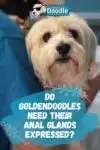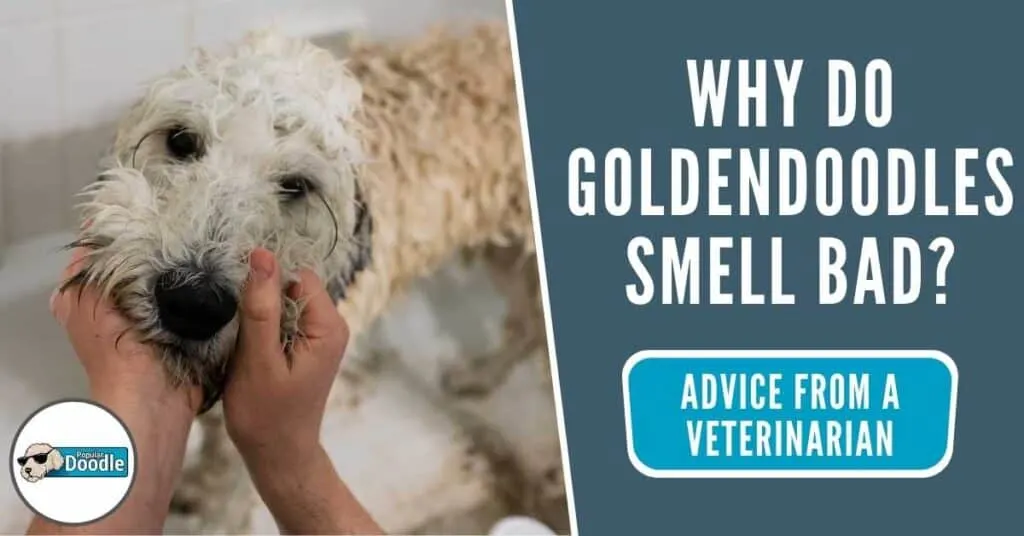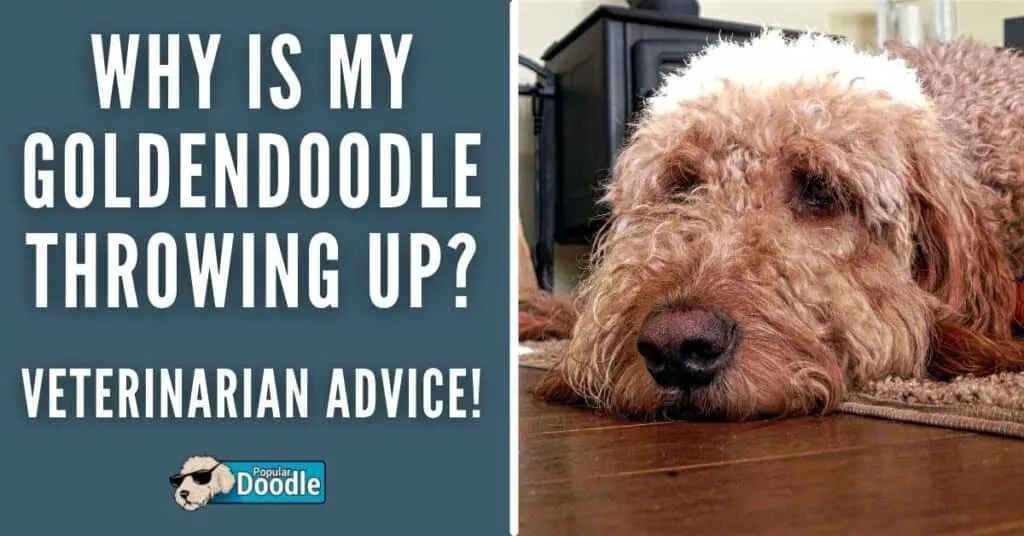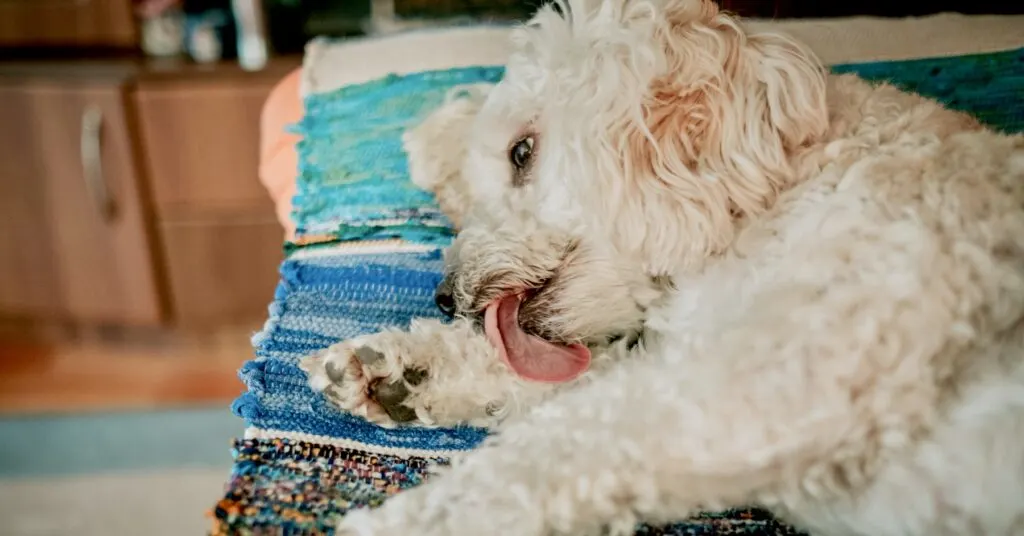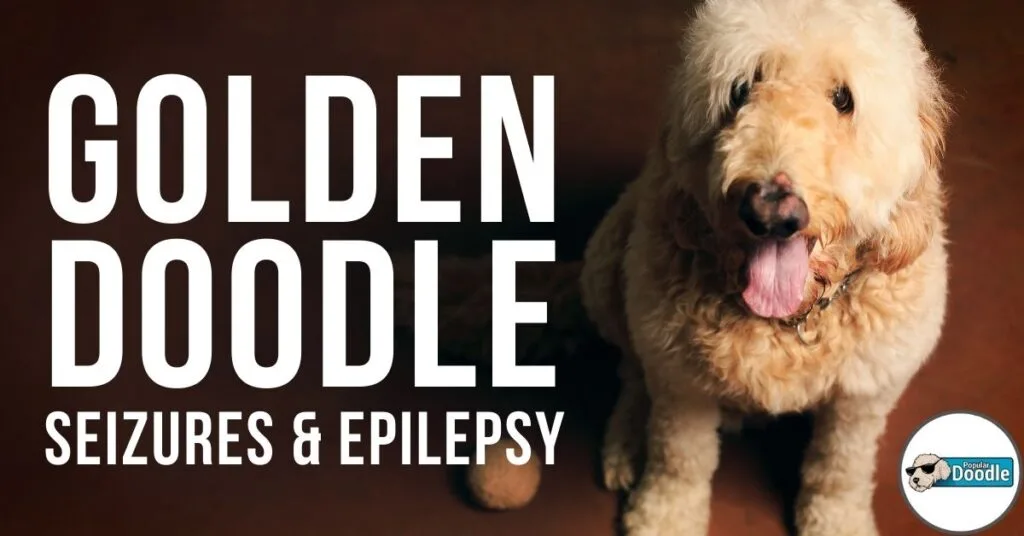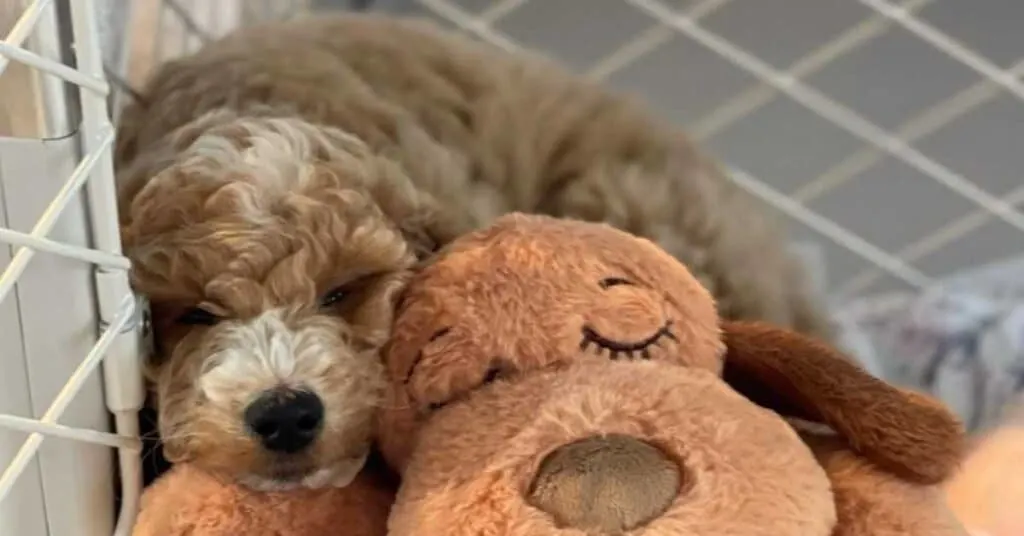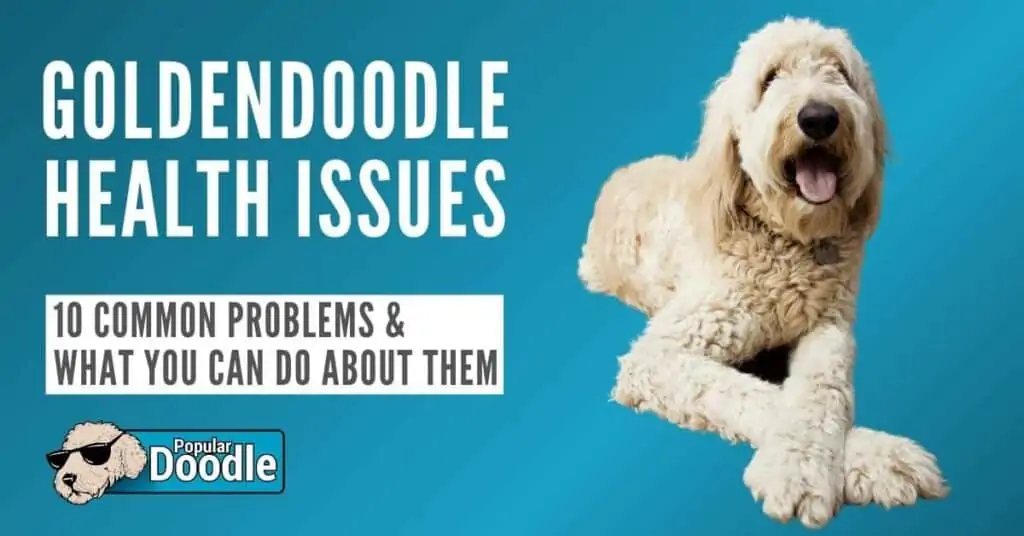By Dr. Merliza Cabriles, D.V.M.
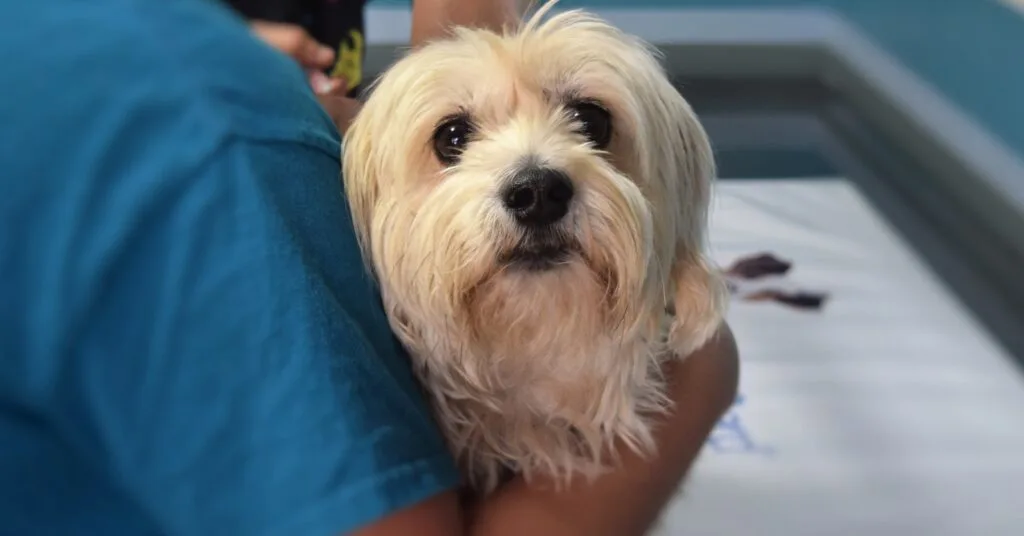
Blocked anal glands are a relatively common problem in dogs, including Goldendoodles. Luckily, this condition can easily be treated.
When left unaddressed, blocked Goldendoodle anal glands can lead to more severe health issues such as impaction, infection, and even rupturing of the anal glands.
If you have noticed your Goldendoodle dragging their rear end across the floor or lawn, it could be a sign of an anal sac issue. Impacted anal glands can be emptied or expressed manually—ask your veterinarian to show you how.
However, frequent anal gland issues with your Goldendoodle warrant a veterinary appointment for proper medical attention and treatment.
Have a question for a vet? Click here to live chat instantly with a verified veterinarian!
What Are Goldendoodle Anal Glands?
Goldendoodle anal glands are two small sacs located on either side of a dog’s anus, just before the rectum. The sacs are scent glands that secrete a strong-smelling fluid. During defecation, the feces exerts pressure on the anal glands on their way out of the anus, causing the release of fluid that coats the stool.
The fluid from a Goldendoodle’s anal glands plays an important role in the following:
Territorial Marking
Anal gland fluid emits a distinct odor Goldendoodles use to mark their territory. When other dogs get a whiff of your pet’s signature scent, they will know that the territory has been claimed.
Social Interaction
The strong-smelling fluid also plays an essential role in social interaction. Your Goldendoodle’s signature scent can reveal a lot about your pet.
Another dog can determine your Goldendoodle’s gender, health condition, temperament, and more just by smelling their feces! It’s no wonder why dogs sniff each other’s butts!
Defense Mechanism
When something startles your Goldendoodle, it may cause them to suddenly empty the entire contents of his anal glands all at once. Experts think this is a defense mechanism by which dogs distract rivals or predators.
What Does it Mean to “Express” Your Dog’s Anal Glands?
To “express” a Goldendoodle’s anal glands means manually squeezing the glands to release their fluid contents. Most dogs don’t need their anal glands expressed manually, but some of our canine companions will need human assistance with this task occasionally or regularly.
If your Goldendoodle frequently experiences anal sac issues, expressing your pet’s anal sacs regularly can prevent pain and discomfort brought about by the buildup of fluid in the glands.
This is certainly not an appealing task for any Goldendoodle owner, however, it’s a very necessary one. If you don’t express your dog’s overly full anal glands, the buildup of fluid can lead to pain, infection, abscess formation, and may even cause the sacs to rupture.
When this happens, your Goldendoodle may need help emptying or “expressing” their anal glands. If you don’t relish the idea of expressing your pet’s anal glands, it can be done by your veterinarian or a professional groomer.
How To Express A Dog’s Anal Glands
Learning how to empty your Goldendoodle’s anal glands is necessary if the problem occurs frequently. This can be a time and money-saving measure because you won’t have to take your pet to the vet or groomer each time there is a problem with your pet’s anal glands.
Before expressing your dog’s anal glands, ensure you have everything you need within easy reach. These include:
- A pair of disposable gloves (plastic or latex)
- Paper towels
- Lubricant (Vaseline or a similar product)
- Washcloth moistened with warm soapy water
It’s a good idea to have somebody help keep your dog still. Gentle restraining is all that’s needed.
Procedure:
- Place your Goldendoodle on a table so it will be easier for you to express their anal glands. They should be standing on all fours.
- Have the person assisting you place an arm around your dog’s neck to act as a cradle while the other arm hugs the rest of your pet’s body. Restraining should be gentle but firm enough to prevent movement.
- Put on a pair of gloves and apply lubrication on your index finger.
- Slowly lift your Goldendoodle’s tail and gently insert your lubricated index finger about an inch into your dog’s rectum.
- Locate each anal gland using your thumb on the outside of the anus and index finger inside the rectum. The right anal gland is at the 4 or 5 o’clock position and the left is at the 7 or 8 o’clock position. The anal glands are like a plum in size and when full, are firm to the touch.
- Once an anal gland is located, place a paper towel in front of your Goldendoodle’s rectal opening before gently exerting light pressure to squeeze out the sac contents. You will know that the gland has been fully expressed when you can barely feel it.
- After you’ve finished with one gland, perform the same procedure on the other gland.
- Once both glands have been emptied, use the washcloth to clean the area.
Here’s a helpful video demonstration:
Warning: If you get disgusted easily, you may want to skip this.
Note that the fluid from the anal glands is brownish and has a thin consistency. You should contact your veterinarian if there are abnormalities in the fluid such as:
- A change in color: gray, yellow, green, etc.
- A change in consistency: thick or chunky
Have a question for a vet? Click here to live chat instantly with a verified veterinarian!
Do Goldendoodles Need Their Anal Glands Expressed?
Many factors can prevent the normal emptying of Goldendoodle anal glands. Some of the most common ones include:
- Smaller and more compact feces brought about by the intake of highly digestible pet food.
- Diarrhea or chronic episodes of soft stools.
- Anatomical abnormalities such as anal glands that are situated deeper under the dog’s skin or at an angle that prevents the sacs from emptying naturally. Smaller ducts may also be a possible cause.
- Health issues such as allergies, infections, trauma, or injury may cause partial obstruction of the ducts and prevent emptying.
- The fluid may be thicker than average, making it difficult to be easily released.
Whatever may be preventing Goldendoodle anal glands from emptying normally, the problem should never be ignored. Even when there is no release of fluid, the cells lining the glands will continue to produce fluid, thus over-stretching the sacs’ storage capacity.
This can be very uncomfortable for your Goldendoodle, causing your pet to scoot or drag his rear across the floor and obsessively lick their anal area. He may be reluctant to move or wag his tail or sit down. Pain may also be present during defecation.
Signs Your Goldendoodle’s Anal Glands Need To Be Expressed
The most prominent signs that indicate your dog has a potential anal sac problem are the following:
- Your Goldendoodle is scooting. Your dog sits down and drags his bottom across the lawn or floor. The behavior may appear weird or funny, but your dog is actually trying to relieve the pain, itching, and discomfort that he’s feeling in his backside, where the anal glands are located. Goldendoodle scooting may also be observed in dogs with intestinal parasites, fleas, or skin allergies.
- They are rubbing their rear end against walls or furniture.
- Your Goldendoodle is licking and/or biting their behind. If your dog starts licking their backside more often, you should examine their behind to know what’s causing the behavior.
The constant scooting, licking, biting, and rubbing can cause hair loss around your dog’s rear end. This can also lead to injury and skin infections.
Your dog may not allow you near their rear end when it has become inflamed and there is bleeding or pus. In this case, veterinary intervention is necessary to address the issue as soon as possible.
Have a question for a vet? Click here to live chat instantly with a verified veterinarian!
Can You Express Your Goldendoodle’s Anal Glands at Home?
If your Goldendoodle frequently experiences anal sac issues, your veterinarian may show you how it’s done so you can do it at home whenever the need arises.
How often a Goldendoodle’s anal sacs should be expressed will depend on the frequency by which your pet displays the typical symptoms described above. If scooting is accompanied by other symptoms, particularly around your pet’s backside, avoid expressing the anal glands. It’s time to have your pet checked out by your veterinarian as soon as possible.

Dr. Merliza Cabriles, D.V.M.
Contributing Professional
Dr. Merliza Cabriles is a licensed veterinarian and university professor with many years of experience in food animal and pet companion medicine. Her passion for writing as well as pet parent education and support is echoed in the articles and ebooks she has written.
Note: While this article is written with Goldendoodles in mind, the information contained is applicable to a wide range of Poodle mix (a.k.a. “doodle”) breeds, including Labradoodles, Bernedoodles, Cavapoos, Maltipoos, etc.

